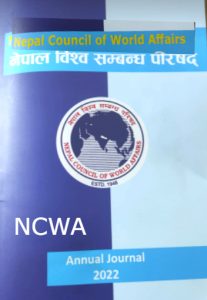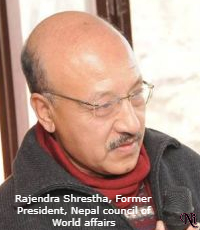Rajendra B. Shrestha
Former President of Nepal Council of World Affairs
Abstract:
Nepal’s unique geo-strategic position has contributed to expand its roles and enhance its strategic significance in the regional as well as the global affairs. South Asia is becoming a new heartland in the 21st century due to the rise of China, India and the encirclement policy of the US. Nepal’s foreign policy is incomplete in the changing geopolitical situation.
India has political, and security, interests as well as in Nepal’s natural resources, trade, and cultural influence. China’s interests are basically security interests, economic interests, and promotion of Chinese influence.
Since China and India are the two rising trade partners, Nepal’s connectivity corridor could provide cost effective transit link in the region and beyond. Nepal must be economically sound and politically stable to take advantages of our unique geo strategic position. It should become a vibrant bridge between the two globally emerging economies by taking advantages of our geo-strategic position and building a national consensus for political stability, economic development, good governance and smart diplomacy.
Changing Global Scenario:
Nepal’s unique geo-strategic position has contributed to expand its role and enhance its strategic significance in the regional as well as the global affairs. Our neighbors are taking interest in Nepal mainly because of its connectivity potential, natural resources and their security concerns. By realizing our geo-strategic importance, immediate neighbors and some established powers are trying to expand their influences in various forms in Nepal.
South Asia is becoming a new heartland in the 21st century due to the rise of China, India and the encirclement policy of the US. Nepal is in the central part of this due to the intense rivalry between China’s BRI and US’MCC projects. The US, China, and India are the key players in this new heartland.
Introduction:
The constitution of Nepal has recognized five major pillars of Nepal’s foreign policy the United Nations Charter of 1945, non-alignment adopted in 1955, Panchsheel (fins principles of peaceful coexistence developed in 1954), international law and norms world peace that emerged in 1943.
Nepal drafted a new foreign policy in 2020. This is the first official comprehensive document of Nepal’s foreign policy comprising nine different priority areas of bilateral relations, multilateral supports, rules-based world order, regional support, economic diplomacy, protection of the rights of natural and legal persons, public diplomacy, tract two diplomacy, and institutional setup.
Although it is a progressive document, it is insufficient because it has failed to examine geopolitics and its implications on foreign policy. Also, it is silent on current global regional, and national geopolitical complexities raised due to global projects like MCC, BRI and IPS. The document has no vision to deal with superpowers. Besides, it ha not specifically predicted any possible threats to Nepal due to bilateral, trilateral, and multilateral geopolitical rivalries.

Challenges:
Nepal’s foreign policy is incomplete, and even irrelevant at times, in the changing geopolitical situation. China, the US, European Union and India are major geopolitical actors in Nepal. The interests of the US and EU in Nepal are almost similar. From this perspective, the major geopolitical actors in Nepal are India, China, Western powers other major nations and developing nations including the LDCs.
India is the most dominant geopolitical actor in Nepal. Nepal has been facing political crises and challenges due to India’s unnecessary intervention in Nepal’s internal affairs. India has political interests, security interests, and interests in natural resources, trade. and cultural influence. To balance those interests, Nepal should develop its India policy accordingly.
The main issue at the moment is related with border regulation, diplomatic negotiations to bring back encroached Nepali territories of Limpiyadhura, Kalapani, Lipulekh and Susta, revisiting the unequal 1950 treaty of peace and friendship, public security and security of natural resources.
Trade imbalance, protectionism and issues of asymmetrical dependence are other areas of concern in addition to cooperation in different cultural, religious aspects for maintaining peace and security.
Likewise foreign policy based on national interest can be shaped through Nepal’s China policy. China’s interests are basically security interests, economic interests, and promotion of Chinese influence. The security interest of China in Nepal include Tibet factor, border regulation, and neutralizing Western engagement in Nepal. Similarly, China’s interest in the larger markets of northern states of India, implementation of BRI, infrastructure development including establishment of industries in Nepal for exporting goods to north Indian states.
Nepal needs more transit facilities from Chinese sea/dry ports, support for connectivity and infrastructural development. Establishment of joint agro-research and production centers, exports of Nepali products to China, tourism promotion and trade balance are some of the economic interests of Nepal with China.
Similarly, Nepal needs to have a separate policy to deal with the West. Western powers have mainly three interests in South Asia-strategic/political, market, and cultural/ democratization interests. Encircling and containing China seems their core strategic interest in Nepal though they never express it openly.
Nepal, on its part, has the obligation to address the security interests of its immediate neighbors China and India. Nepal has to safeguard its economic interests from Western attempts to disrupt the Sino-Indian market while preserving its religions and culture from Western influence and dominance.
Finally, Nepal also needs to have a policy for the rest of the world. This policy should include 152 developing countries, 46 least developed countries (LDCs), and other emerging powers.
These countries simply do not have much political and security interests in Nepal. They have interests in economic development and prosperity. Nepal should gear up economic as well as South-South Cooperation with those countries. This policy should cover South Asian countries (except India), the destination countries of Nepali workers, international organizations especially from South Asia, Asia, including Nepali diaspora.
Opportunities:
Nepal, with its critical geo-strategic position between the two Asian giants constitutes an integral part in their strategic interests in South Asian Region (SAR).
Cordial Sino Nepal relations have provided an opportunity for China to expand its multi-faceted engagements in Nepal which were earlier enjoyed by the southern neighbor. It can provide shortest China – SAR gateway, particularly to a large Indian market of Uttar Pradesh (UP) and Bihar.
President Xi Jinping’s commitment during his visit to fully support Nepal becoming a “land-linked” state demonstrates that China is willing to play a dynamic role in Nepal Indian hegemonic behavior along with the number of problems in Indo-Nepal relations such as unequal treaties, border encroachment, political instability in Terai /Madesh trade and commerce water resources have created an opportunity for the rise of China influence in Nepal.
Competition and rivalry between India and China has made Nepal an indispensable component of their strategic interests, enhancing our values not only within SAR but also in the Indo-Pacific region. Nepal is also important for the strategic interests of US and wants to keep on its radar by helping in its socio-economic development, democrat and security.
China perceives that cordial and friendly Sino-Nepal relations could support them, resolve genuine problems in the future in TAR, including the Indo-US’s potential threat in the region. Nepal’s geo-strategic position comes in the front in these equations where China respects Nepal as a reliable neighbor.
China’s main concern in Nepal is primarily the US not India. China suspects that the US and its allies are trying to use Nepal in their larger strategy of encircling and containing it.
This has led China to be more active in Nepal in recent years. Nepal’s participation in Belt and Road Initiative ( BRI) includes connectivity through Trans-Himalayan Multi-Dimensional network, trade, energy, people to people, finance and the whole spectrum of connectivity.
The strategic agreement will give Nepal access to Chinese sea/dry ports. It can potentially project Nepal to be a strategic force in the region.

Nepal corridor will open up new opportunities for inter-regional economic cooperation. Since China and India are the two rising global trade partners, Nepal’s connectivity corridor could provide cost effective and time saving transit link in the region.
Nepal provides an immense strategic relevance to the Indian security as well. India anxiety is that any overwhelming foreign interests have the possibility of Nepali territory being used in anti-India activities, including their security and strategic interests.
Nepal has tremendous potential to become a top destination for tourists as it is famous for its snow capped mountains with eight of 10 highest mountains of the world including Mt. Everest, abundant flora and fauna, exciting trekking routes and rich cultural and religious heritage. Nepal is located between the two most populous countries China (1. 4 ) and India (1.35 b). Even if only 0.50 percent (14 million) of them visit Nepal even year, it will boost Nepali economy tremendously.
Climate change is adversely impacting Nepal disproportionately compared to its size and negligible contribution to greenhouse effects. Our mountains are becoming more vulnerable due to increased carbon emission and extreme altitude variation. Nepal’s central location in the Himalayas between the two industrial giants could be an ideal location for global climate change experiments.
Most of the large rivers in the SAARC/BBIN/BIMSTEC region originate from the Himalayas and mountains. Mountains, with their tremendous potential for hydroelectricity and vital ecosystem, play significant roles in economic development, environmental protection, ecological sustainability and human well being.
Like “blue economy” for maritime nations, mountains of Nepal possess remarkable potential for “mountain economy and benefit lowland nations in the region as well.
Conclusion:
No nation can be regarded as truly independent if it is not economically independent.
No nation can be really sovereign if it is not able to solve its problems on its own. Nepal’s independence and sovereignty have been challenged by the economic realities and political conditions.
Economic independence is not possible without development, which is impossible without mobilizing internal human and natural resources.
Therefore, Nepal must be economically sound and politically stable to take maximum advantages from our unique geo-strategic position.
Our geo-strategic position demands that Nepal cannot be a part of any strategic alliance which may destabilize relations with immediate neighbors and cordial relations with other nations.
Our foreign policy starts with China, India and the neighborhood and goes beyond. Active involvement in the United Nations and its instruments, multilateralism, nonalignment and equi-proximity relations with immediate neighbors.” is the fundamental aspects of Nepal’s foreign policy.
We must develop this nation with the goodwill, support and cooperation of neighbors and established powers.
Nepal must put an end to playing diplomatic card, one neighbor against the other.
We must have balanced diplomacy with both neighbors, a strategy severely constrained by a weak Ministry of Foreign Affairs. This is further aggravated with the appointment of party indoctrinated diplomatic cadres with no or limited diplomatic skills and international exposure.
The future of the China-Nepal-India relation will depend on Nepal’s foreign policy skills to safely navigate and stand by its national interests.
Nepal is an important partner in the BRI.
Although there is some concern of falling into debt-trap which can be avoided by aligning infrastructure development along BRI plans and a proactive diplomacy.
We must understand the consequences of over-dependency on one neighbor over the other.
Similarly, since US is one of our oldest and reliable development partners and also the largest contributor to the United Nations, it can help Nepal in various platforms of the United Nations.
The MCC compact being solely a development package (not like the quad arrangement under IPS), it will not be wise to reject it which may adversely affect our diplomatic credibility in international cooperation. However we should carefully assess its implications on our sovereignty, independence and non-aligned foreign policy before making a final decision.
Nepal’s dream of becoming a transit/linked state cannot be significantly affected by the Sino-Indian political differences. It will open South Asia door to China and support India to expand its reach to Tibetan Autonomous region (TAR) and Central Asia region (CAR) by significantly reducing transportation costs.
To achieve this goal, w should skillfully coordinate and negotiate in bringing the two neighbors together to forge trilateral cooperation in a mutually beneficial win-win situation.
Spearheaded by China and India, Asia is emerging as the dominant global economy the twenty-first Century. Land connectivity between these countries is central to the development of intra-Asian trade networks. There is also a possibility of inter-regional trade and commerce between SAR, ASEAN and CAR. The India-Nepal-China corridor can become an integral part of this.
The geopolitical risks for Nepal due to its geo-strategic position are high. In the new world order, it is extremely difficult for small states to remain indifferent, non committal, or neutral to the gravitational pull of powerful states. Therefore, we must soon transform our dynamic geo-strategic significance into a soft power asset and avoid possibilities of being the victim of great power politics by introducing smart diplomacy and cooperative partnership in the region.
Our geo-strategic position offers greater possibilities of closer China-Nepal-India cooperation by means of trans-Himalayan Multi-Dimensional Connectivity. This will not only benefit these nations but also enhance inter-/intra-regional trade and commerce We cannot afford to be land-locked country anymore.
We need to become a vibrant bridge between the two emerging global economies by taking advantages of our geo strategic position and building a national consensus for political stability, economic development, good governance and smart diplomacy.
Nepal will begin a path to prosperity and earn respect and dignity from our friendly partners especially our southern and northern neighbors if the leaders realize and adhere to these values. Nepal needs to capitalize on this new opportunity and be prepared to benefit from cooperation in development programs of mutual interests that will lead to economic development and prosperity.
End Text.
Text courtesy: Nepal Council of World Affairs ( NCWA) Annual Journal, 2022.
Journal received through the kind courtesy of Buddhi Narayan Shrestha-the Vice President of the NCWA.
# Thanks the distinguished author and the entire NCWA executive team.
Our contact email address is: editor.telegraphnepal@gmail.com
Reference:
Acharya, G.P. (2018). The bigness of smallness published in Nepal Niti. Available at
https://www.nepalniti.com/2019/04/17843/.
Acharya, J. (2008). Nepal’s new foreign policy agenda. Kathmandu: IFA.
Bhardwaj, N. (2020). BRI and Indo Pacific Strategy . The Rising Nepal: Kathmandu.
Dahal, G. (2018). Foreign relation of Nepal with China and India. Journal of Political
Science, Volume XVIII, 2018.
Shrestha R.B. (2019). Nepal’s Foreign Policy Challenges and Opportunities in the
Changed Context. Nepal Council of World Affairs. Annual Journal, 2019: Kathmandu.

